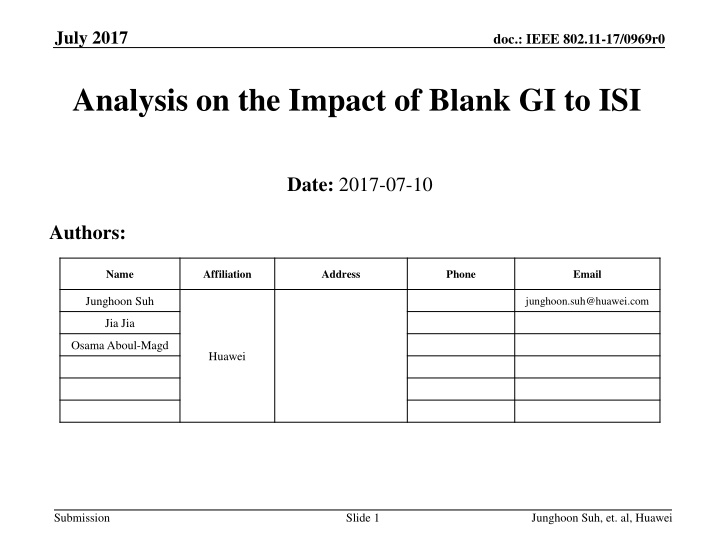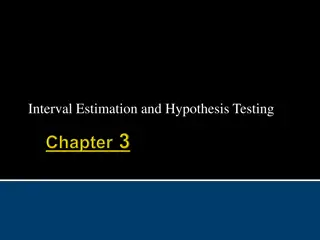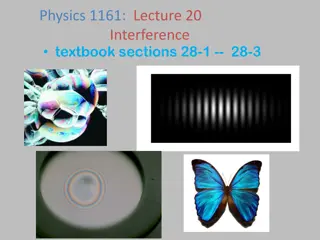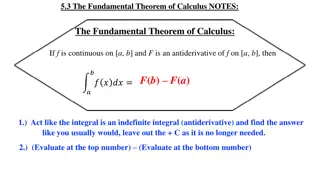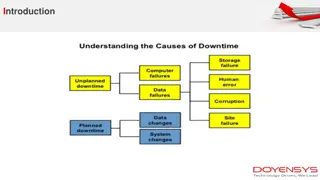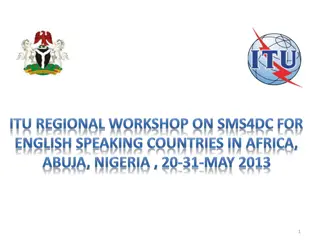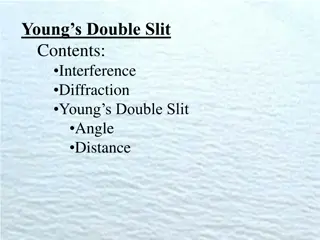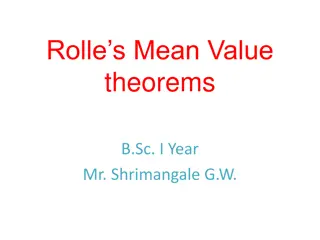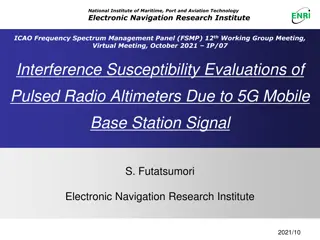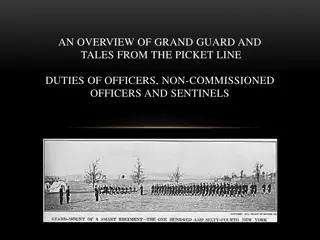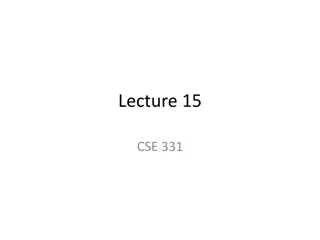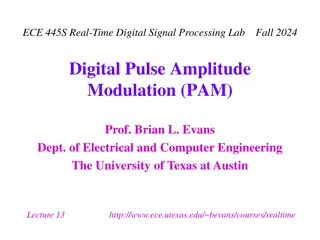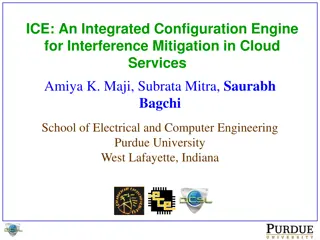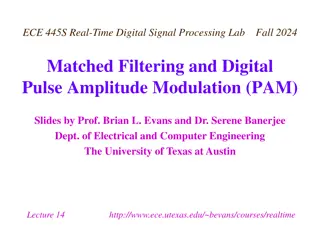Analysis on Impact of Blank Guard Interval to Inter-Symbol Interference
Performance gain was observed with Blank GI in coping with Inter-Symbol Interference (ISI). However, Intra-Symbol Interference still remains. Three Waveform Coding Designs were evaluated for their effectiveness. The study analyzed the effects of Blank GI on ISI and Intra-Symbol Interference to enhance signal reliability.
Download Presentation

Please find below an Image/Link to download the presentation.
The content on the website is provided AS IS for your information and personal use only. It may not be sold, licensed, or shared on other websites without obtaining consent from the author.If you encounter any issues during the download, it is possible that the publisher has removed the file from their server.
You are allowed to download the files provided on this website for personal or commercial use, subject to the condition that they are used lawfully. All files are the property of their respective owners.
The content on the website is provided AS IS for your information and personal use only. It may not be sold, licensed, or shared on other websites without obtaining consent from the author.
E N D
Presentation Transcript
July 2017 doc.: IEEE 802.11-17/0969r0 Analysis on the Impact of Blank GI to ISI Date: 2017-07-10 Authors: Name Affiliation Address Phone Email Junghoon Suh junghoon.suh@huawei.com Jia Jia Osama Aboul-Magd Huawei Submission Slide 1 Junghoon Suh, et. al, Huawei
July 2017 doc.: IEEE 802.11-17/0969r0 Background Performance gain was observed during the RX filtering and over IEEE Chan D with Blank GI pre-pended WFC [1] The proposed Blank GI is effective to cope with Inter Symbol Interference (ISI), however still the Intra Symbol Interference remains Analysis on Blank GI impact to ISI and Intra Symbol Interference Submission Slide 2 Junghoon Suh, et. al, Huawei
July 2017 doc.: IEEE 802.11-17/0969r0 Three Waveform Coding Designs L-LTS occupied for middle 13 tones to generate the waveform Equal symbol energy of WFC I, II, and III TX power is boosted per i and q sample by , where 2, 2.5, 3.33 correspond to 4us/2us, 4us/1.6us, 4us/1.2us, respectively for WFC I, II, and III , 2 , 5 . 2 . 3 33 WFC I : No CP 0us 2us 4us 0us 2us 4us Information 1 Information 0 Time dispersion ISI area Submission Slide 3 Junghoon Suh, et. al, Huawei
July 2017 doc.: IEEE 802.11-17/0969r0 WFC II: A blank energy GI with 0.8us duration is placed before transmitting each of the 3.2us symbol. The GI is removed at RX before performing symbol detection. Blank Blank 0us 0.8us 2.4us 4us 0us 0.8us 2.4us 4us Information 1 Information 0 WFC III: A blank energy GI with 0.8us duration is placed before each of the 1.2us ON and OFF portion in a Symbol. The GI is removed at RX before performing symbol detection. ON OFF Blank GI OFF ON Blank GI Blank GI Blank GI 0us 0.8us 2.0us 2.8us 4us 0us 0.8us 2.0us 2.8us 4us Information 0 Information 1 Submission Slide 4 Junghoon Suh, et. al, Huawei
July 2017 doc.: IEEE 802.11-17/0969r0 Analysis on Inter and Intra Symbol Interference WFC I : No CP For the simplification of the analysis, it is assumed to have 5 samples per ON portion, and 5 samples per OFF portion. Analysis is done over 4 symbols (4 bit WUR data) Delay spread is assumed to be across two samples 2us 4us 8us 6us 10us 12us 14us ON OFF ON (OFF) OFF (ON) ON (OFF) OFF (ON) ON (OFF) OFF (ON) OFF ON OFF (ON) ON (OFF) OFF (ON) ON (OFF) OFF (ON) ON (OFF) 5 samples are not mixed with another portion or symbol in a different energy weight 1, weight 0 otherwise Submission Slide 5 Junghoon Suh, et. al, Huawei
July 2017 doc.: IEEE 802.11-17/0969r0 Sum of weights 0 1 2 1 2 3 2 1 Sum of weights 1 2 3 2 1 2 1 0 0 0 0 0 0 0 0 0 0 0 0 0 1 1 1 1 0 0 1 1 0 0 1 1 0 1 0 1 0 1 0 1 1 1 1 1 1 1 1 1 0 0 0 0 1 1 1 1 0 0 1 1 0 0 1 1 0 1 0 1 0 1 0 1 0 : OFF ON 1: ON - OFF 2 6 6 = + + 5 . 1 = Sum of Weights 3 2 E 16 16 16 Submission Slide 6 Junghoon Suh, et. al, Huawei
July 2017 doc.: IEEE 802.11-17/0969r0 WFC II : Blank GI pre-pended to a Symbol For the simplification of the analysis, it is assumed to have 2 samples per Blank GI, 4 samples per ON portion, and 4 samples per OFF portion. Analysis is done over 4 symbols (4 bit WUR data) Delay spread is assumed to be across two samples 4 samples are not mixed with another portion or symbol weight 1, weight 0 otherwise Removed by GI removal 4us 8us 12us ON OFF ON OFF ON OFF ON OFF OFF (1) ON OFF (1) ON OFF (1) ON OFF (1) ON 1 1 1 1 = + + + = Sum of Weights 2 E 2 2 2 2 Submission Slide 7 Junghoon Suh, et. al, Huawei
July 2017 doc.: IEEE 802.11-17/0969r0 WFC III : Blank GI pre-pended to each ON/OFF portion For the simplification of the analysis, it is assumed to have 2 samples per Blank GI, 3 samples per ON portion, and 3 samples per OFF portion. Analysis is done over 4 symbols (4 bit WUR data) Delay spread is assumed to be across two samples 3 samples are not mixed with another portion or symbol weight 1, weight 0 otherwise Removed by GI removal 4us 8us 12us ON OFF (1) ON OFF (1) ON OFF (1) ON OFF (1) OFF (1) ON OFF (1) ON OFF (1) ON OFF (1) ON 1 1 1 1 = + + + = Sum of Weights 2 2 2 2 4 E 2 2 2 2 Submission Slide 8 Junghoon Suh, et. al, Huawei
July 2017 doc.: IEEE 802.11-17/0969r0 Trivial for the Analysis The expected value of the sum of weights indicates the performance of compensating the ISI, Inter Portion Interference as well as Intra Symbol Interference WFC III > WFC II > WFC I The gain of the expected value is always 3 dB between WFC III and WFC II regardless of the number of symbols The gain of the expected value between WFC II and WFC I depends on the number of symbols, that is, the larger the size of symbols, the bigger gain on the expected value is observed Time diversity to compensate the deep fades of the channel is not considered in the analysis WFC I > WFC II > WFC III for time diversity Spectrum in the freq domain gets increased for the shorter pulse in time domain WFC III > WFC II > WFC I for the size of the side lobes in freq domain Submission Slide 9 Junghoon Suh, et. al, Huawei
July 2017 doc.: IEEE 802.11-17/0969r0 Performance of different RX Filter Taps w/ or w/o Blank GI Packet size, 100 bits AWGN and RF impairments (CFO and Phase noise) considered Submission Slide 10 Junghoon Suh, et. al, Huawei
July 2017 doc.: IEEE 802.11-17/0969r0 Performance over Chan D Waveform Coding applied with L-LTS based waveform generation Over-sampled to 100 MHz and TX filter applied @ 4MHz BW and 100 MHz Sampling rate for the image rejection After Chan D is applied, down-convert the signal to 20 MHz sampling rate based signal and then AWGN is added 20 MHz based SNR LPF at the RX is applied @ 4 MHz BW and 20 MHz sampling rate Packet size, 100 bits RF impairments (CFO and Phase noise) considered Submission Slide 11 Junghoon Suh, et. al, Huawei
July 2017 doc.: IEEE 802.11-17/0969r0 RF impairments Baseband model RF impairments Phase Noise Carrier Freq Offset AWGN Baseband Signal + X X Phase Noise AWGN 2 j fn e CFO is 200 ppm of 2.4 GHz, i.e., -240 KHz ~ 240 KHz Linearly shifts every 4 usec (based on 802.11 residual CFO model) n varies linearly every 4 usec in 4 usec is the data rate, 250 KHz 2 je fn Phase noise based on 802.11 phase noise model Submission Slide 12 Junghoon Suh, et. al, Huawei
July 2017 doc.: IEEE 802.11-17/0969r0 Conclusion Analysis and more simulations are provided WFC III shows the best in the analysis In consideration of the time diversity and spectrum efficiency, WFC II is a good choice between ISI compensation and time diversity Smaller filter taps are better to avoid ISI and Intra Symbol Interferences Trade-off between Interference rejection and ISI We will follow the filter design according to EVM documentation, once it is decided Submission Slide 13 Junghoon Suh, et. al, Huawei
July 2017 doc.: IEEE 802.11-17/0969r0 Reference [1] Junghoon Suh, et. al. 17/696r0 Blank GI for the Waveform Coding , IEEE 802.11 TGba, May 2017, Daejeon, South Korea Submission Slide 14 Junghoon Suh, et. al, Huawei
